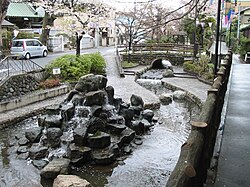Loading AI tools
Special ward in Kantō, Japan From Wikipedia, the free encyclopedia
Edogawa (江戸川区, Edogawa-ku) is a special ward in the Tokyo Metropolis in Japan. It takes its name from the Edo River that runs from north to south along the eastern edge of the ward. In English, it uses the name Edogawa City.
This article needs additional citations for verification. (August 2018) |
Edogawa
江戸川区 | |
|---|---|
| Edogawa City[1] | |
 Furukawa Waterside Park in Edogawa | |
 Location of Edogawa in Tokyo Metropolis | |
| Coordinates: 35°42′N 139°53′E | |
| Country | Japan |
| Region | Kantō |
| Prefecture | Tokyo Metropolis |
| First official recorded | 721 AD |
| As City of Tokyo | October 1, 1932 |
| As Special ward of Tokyo | July 1, 1943 |
| Government | |
| • Mayor | Takeshi Saitō (since April 2019) |
| Area | |
| • Total | 49.90 km2 (19.27 sq mi) |
| Population (October 1, 2020[2]) | |
| • Total | 697,932 |
| • Density | 13,986/km2 (36,220/sq mi) |
| Ethnic groups | |
| Time zone | UTC+09:00 (JST) |
| Climate | Cfa |
| Website | www |
| Symbols | |
| Flower | Rhododendron |
| Tree | Cinnamonum camphora |

The easternmost of the wards, it shares boundaries with the cities of Urayasu and Ichikawa in Chiba Prefecture (to the east) and with the wards of Katsushika (to the north), Sumida and Kōtō (to the west). It meets the city of Matsudo in Chiba at a point.
Edogawa has a sister-city relationship with Gosford, New South Wales, Australia. Domestically, it has friendship ties with the cities of Azumino in Nagano Prefecture and Tsuruoka in Yamagata Prefecture.
As of January 1, 2020, the ward has an estimated population of 695,797, and a population density of 13,925 persons per km2. [citation needed] The total area is 49.90 km2.
This section needs expansion. You can help by adding to it. (May 2021) |
The ward was founded in 1937 with the merger of seven towns and villages in Minami-Katsushika District: the towns of Koiwa and Komatsugawa, and the villages of Kasai, Matsue, Mizue, Shinozaki and Shikamoto.
| Climate data for Edogawa, Tokyo (1991−2020 normals, extremes 1976−present) | |||||||||||||
|---|---|---|---|---|---|---|---|---|---|---|---|---|---|
| Month | Jan | Feb | Mar | Apr | May | Jun | Jul | Aug | Sep | Oct | Nov | Dec | Year |
| Record high °C (°F) | 20.1 (68.2) |
24.1 (75.4) |
25.3 (77.5) |
26.2 (79.2) |
31.2 (88.2) |
34.3 (93.7) |
38.0 (100.4) |
37.8 (100.0) |
35.1 (95.2) |
32.0 (89.6) |
25.2 (77.4) |
24.4 (75.9) |
38.0 (100.4) |
| Mean daily maximum °C (°F) | 9.8 (49.6) |
10.5 (50.9) |
13.4 (56.1) |
18.0 (64.4) |
22.2 (72.0) |
25.0 (77.0) |
28.6 (83.5) |
30.3 (86.5) |
27.0 (80.6) |
21.9 (71.4) |
17.0 (62.6) |
12.2 (54.0) |
19.7 (67.4) |
| Daily mean °C (°F) | 6.0 (42.8) |
6.5 (43.7) |
9.4 (48.9) |
14.0 (57.2) |
18.4 (65.1) |
21.5 (70.7) |
25.1 (77.2) |
26.7 (80.1) |
23.6 (74.5) |
18.4 (65.1) |
13.3 (55.9) |
8.4 (47.1) |
15.9 (60.7) |
| Mean daily minimum °C (°F) | 2.4 (36.3) |
2.8 (37.0) |
5.6 (42.1) |
10.3 (50.5) |
15.1 (59.2) |
18.8 (65.8) |
22.6 (72.7) |
24.2 (75.6) |
20.9 (69.6) |
15.5 (59.9) |
9.9 (49.8) |
4.9 (40.8) |
12.8 (54.9) |
| Record low °C (°F) | −3.7 (25.3) |
−3.8 (25.2) |
−4.1 (24.6) |
0.7 (33.3) |
7.1 (44.8) |
11.5 (52.7) |
14.7 (58.5) |
17.0 (62.6) |
12.3 (54.1) |
6.3 (43.3) |
0.5 (32.9) |
−2.9 (26.8) |
−4.1 (24.6) |
| Average precipitation mm (inches) | 50.1 (1.97) |
50.9 (2.00) |
103.0 (4.06) |
111.8 (4.40) |
122.5 (4.82) |
150.3 (5.92) |
129.1 (5.08) |
108.0 (4.25) |
195.7 (7.70) |
205.7 (8.10) |
90.5 (3.56) |
53.3 (2.10) |
1,364 (53.70) |
| Average precipitation days (≥ 1.0 mm) | 4.9 | 5.4 | 9.5 | 9.7 | 10.1 | 11.7 | 10.1 | 7.4 | 11.0 | 10.5 | 7.9 | 5.5 | 103.7 |
| Source: JMA[3][4] | |||||||||||||
This section needs expansion. You can help by adding to it. (April 2024) |
As of 2018[update] 3,758 people of Indian ancestry, about 10% of the people of Indian origin in Japan and about 30% of the people of Indian origin in Tokyo Metropolis, reside in Edogawa Ward. The Nishikasai area has a high concentration of Indian origin families. The Indian community increased when engineers came to Japan to fix the Y2K bug. Indian people settled in Nishikasai due to the proximity to the Tokyo Metro Tozai Line, which connects to their places of employment.[5]
Nishikasai includes the Edogawa Indian Association. The head of the organization as of 2023, Jagmohan S. Chandrani, has been called the "father of Little India."[6]
Restaurants serving the cuisine of northern India opened in the northern part of the community, while the southern part had southern Indian restaurants. Global Indian International School Tokyo caters to the Indian expatriate community.[5]
|
|
|
Universities
Metropolitan high schools are operated by the Tokyo Metropolitan Government Board of Education.
Private High Schools:
International schools:
Public elementary and junior high schools are operated by the Edogawa Board of Education (江戸川区教育委員会).
Junior high schools:[15]
Elementary schools:[16]
Seamless Wikipedia browsing. On steroids.
Every time you click a link to Wikipedia, Wiktionary or Wikiquote in your browser's search results, it will show the modern Wikiwand interface.
Wikiwand extension is a five stars, simple, with minimum permission required to keep your browsing private, safe and transparent.